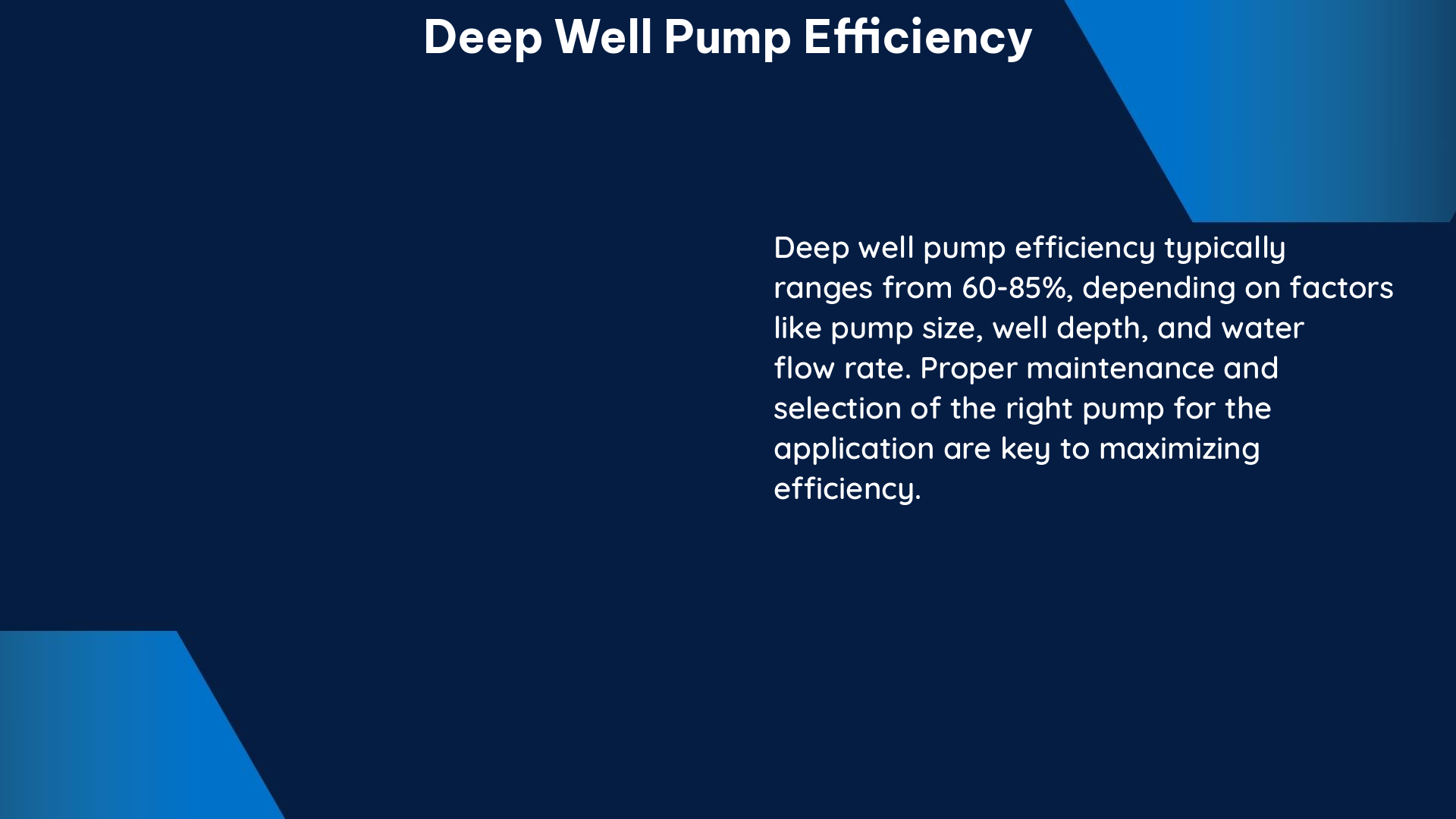Deep well pump efficiency is a critical factor in the overall performance and cost-effectiveness of a water well system. By understanding and measuring key efficiency metrics, well owners and operators can make informed decisions about maintenance, rehabilitation, and equipment upgrades. This comprehensive guide will delve into the technical details of deep well pump efficiency, providing a wealth of information to help you optimize your water well system.
Understanding Specific Capacity
Specific capacity is a crucial metric for evaluating deep well pump efficiency. It is defined as the volume of water produced per unit time (discharge, Q) divided by the vertical distance between the static, non-pumping water level and the pumping water level (drawdown, s). The greater the drawdown, the higher the power costs.
Specific capacity is a measure of well performance (Q/s) indicating the amount of water that is available per unit drawdown. A decrease in specific capacity is an indication of well fouling, which may require rehabilitation rather than maintenance to restore lost capacity.
To calculate specific capacity, you can use the following formula:
Specific Capacity = Q / s
Where:
Q = Discharge (volume of water produced per unit time)
s = Drawdown (vertical distance between static and pumping water levels)
For example, if a well produces 100 gallons per minute (GPM) with a drawdown of 20 feet, the specific capacity would be:
Specific Capacity = 100 GPM / 20 feet = 5 GPM/ft
This means the well can produce 5 gallons of water per minute for every foot of drawdown.
Measuring Pump Efficiency

Pump efficiency is defined as the ratio of water horsepower output from the pump to the shaft horsepower input for the pump. Water horsepower is determined by the flow rate and pressure delivered from the pump, while the shaft horsepower is delivered to the pump from the power unit, which is usually an electric motor or internal combustion engine.
To calculate pump efficiency, you can use the following formula:
Pump Efficiency = (Water Horsepower / Shaft Horsepower) x 100%
Where:
Water Horsepower = (Flow Rate x Discharge Pressure) / 3960
Shaft Horsepower = (Flow Rate x Total Dynamic Head) / (3960 x Pump Efficiency)
Pump efficiency testing can accurately quantify pump and well performance and efficiency changes, and can help identify when a well requires maintenance or rehabilitation.
Other Efficiency Metrics
In addition to specific capacity and pump efficiency, there are several other useful well efficiency terms that can provide a more comprehensive understanding of your water well system:
- Standing Water Level: The depth from the ground surface to the water level in the well when the pump is not running.
- Recovered Water Level: The depth from the ground surface to the water level in the well after the pump has been turned off and the water level has recovered.
- Drawdown: The difference between the standing water level and the pumping water level.
- Pumping Water Level: The depth from the ground surface to the water level in the well while the pump is running.
- Discharge Pressure at Gauge: The pressure measured at the discharge of the pump.
- Total Lift: The vertical distance the water is lifted from the pumping water level to the discharge point.
- Overall Plant Efficiency: The overall efficiency of the entire water well system, including the pump, motor, and well.
Evaluating Overall Plant Efficiency
The overall plant efficiency can be generally characterized as follows:
| Efficiency Range | Evaluation |
|---|---|
| 60% and higher | Excellent |
| 50% to 60% | Good |
| 49% or less | Indicates a pump that may need a retrofit, repair, or adjustment. It also may indicate the pump is not matched to the current required operating conditions. |
It’s important to note that pumps with submersible motors will usually run about 10% lower efficiency in each of the categories above. For example, 50% or above would be considered excellent for a submersible pump.
Importance of Regular Pump Efficiency Testing
Regular pump efficiency testing is crucial for maintaining the performance and cost-effectiveness of your deep well pump system. By monitoring key efficiency metrics, you can:
- Identify Potential Issues: Pump efficiency testing can help identify problems before they become major issues, such as well fouling or pump wear.
- Optimize System Performance: By understanding the efficiency of your pump and well, you can make informed decisions about maintenance, rehabilitation, or equipment upgrades to improve overall system performance.
- Reduce Operational Costs: Improving pump and well efficiency can lead to significant cost savings in terms of energy consumption and maintenance expenses.
- Extend Equipment Lifespan: Proactive maintenance and optimization of your deep well pump system can help extend the lifespan of your equipment, reducing the need for costly replacements.
Conclusion
Mastering deep well pump efficiency is essential for maintaining the performance and cost-effectiveness of your water well system. By understanding and measuring key efficiency metrics, such as specific capacity and pump efficiency, you can make informed decisions about maintenance, rehabilitation, and equipment upgrades. Regular pump efficiency testing is crucial for identifying potential issues, optimizing system performance, reducing operational costs, and extending the lifespan of your equipment. This comprehensive guide has provided you with the technical details and practical knowledge to effectively manage the efficiency of your deep well pump system.
References:

The lambdageeks.com Core SME Team is a group of experienced subject matter experts from diverse scientific and technical fields including Physics, Chemistry, Technology,Electronics & Electrical Engineering, Automotive, Mechanical Engineering. Our team collaborates to create high-quality, well-researched articles on a wide range of science and technology topics for the lambdageeks.com website.
All Our Senior SME are having more than 7 Years of experience in the respective fields . They are either Working Industry Professionals or assocaited With different Universities. Refer Our Authors Page to get to know About our Core SMEs.